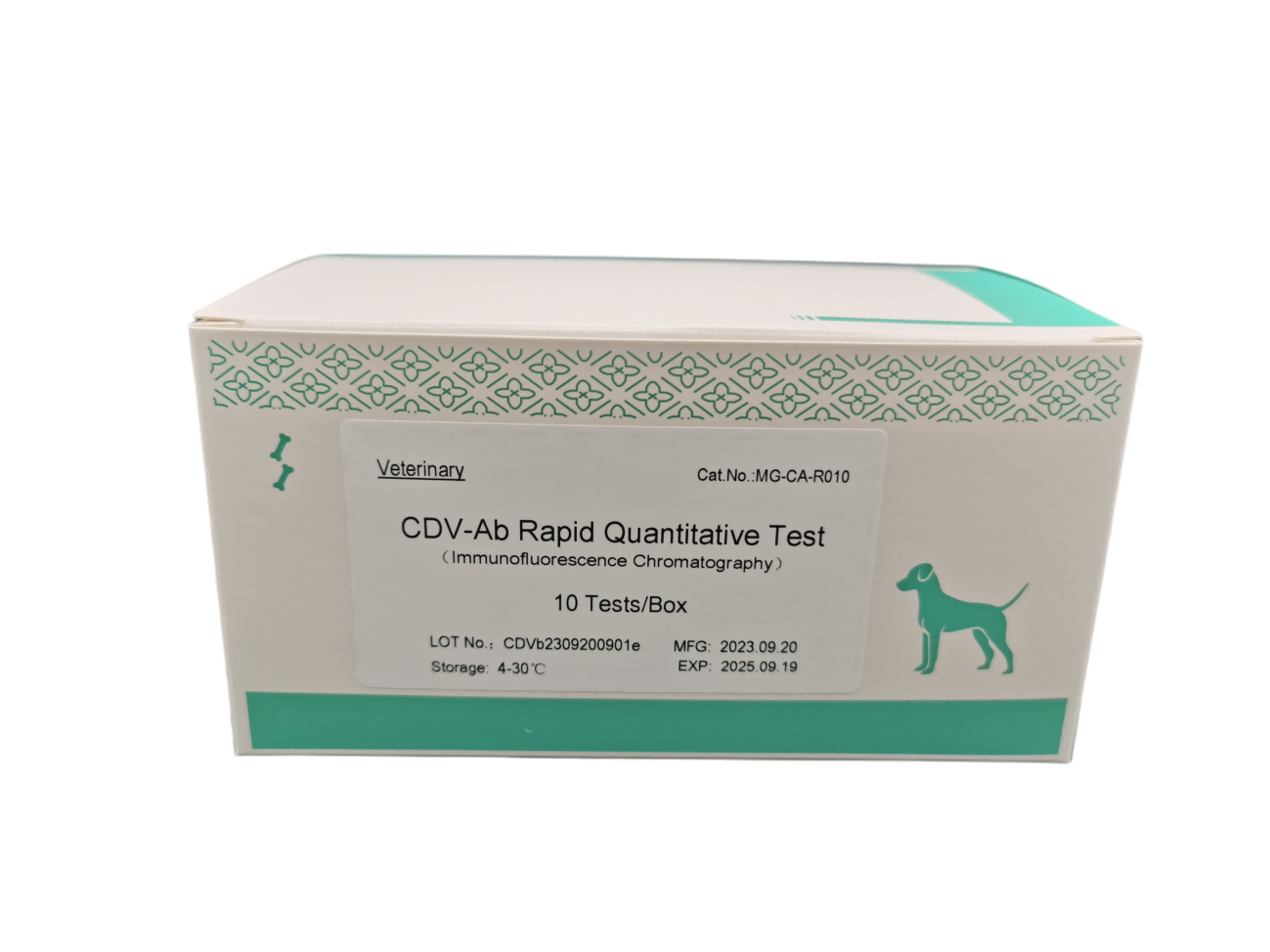


Key attributes

SPECIFICATION
Package Size: 10 Tests/Box
Catalog Number: MG-CA-R009
The CPV-Ab test is a fluorescence immunoassay used with an Immunofluorescence Analyzer to quantitatively determine parvovirus antibody (CPV-Ab) concentration in canine serum or plasma. This test aids in assessing the CPV-Ab titer after vaccination, providing guidance on the necessity for re-vaccination. It is also useful for diagnosing and monitoring canine parvovirus infection.
For in vitro diagnostic use only. For professional use only.
Utilizes a quantitative double-antigen sandwich fluorescence immunoassay technique.
The fluorescent signal intensity indicates the amount of CPV-Ab captured, with results expressed in Tu/ml.
| Contents | Quantity |
|---|---|
| Individual Sealed Pouches | 10 |
| - Test Device | Per pouch |
| - Desiccant Pouch | Per pouch |
| ID Chip | 1 |
| Instructions for Use | 1 |
| Sample Buffer Tubes | 10 |
| Pipette Tips | 10 |
Materials Required but Not Provided:
| Material | Quantity |
|---|---|
| Immunofluorescence Analyzer | 1 |
| Timer | 1 |
| Pipette | 1 |
| Centrifuge | 1 |
Store the test kit at 4–30℃ until the expiration date.
Operate the test at 18–28℃ after opening the Test Device.
Perform the test within 30 minutes after opening the pouch.
Suitable for use with serum or plasma (EDTA anticoagulant recommended).
Separate serum or plasma from blood within 3 hours of collection. If severely hemolyzed, obtain a new specimen.
Ideally, test immediately after specimen collection. If testing is delayed, store the specimen at 2–8℃ for up to 72 hours or below -20℃ for long-term storage.
Bring all materials to room temperature before use. Thaw frozen specimens completely and mix well. Avoid repeated freezing and thawing. Use only clear, non-hemolyzed specimens.
Refer to the Immunofluorescence Analyzer Operation Manual for detailed instructions.
Place the Test Device on a clean, level surface.
Insert the ID Chip into the analyzer and click "Read ID Chip." Verify that the Test Device lot number matches the ID Chip number.
Pipette 20 μl of prepared sample into the CPV-Ab Sample Buffer and mix gently to avoid vigorous agitation and foaming.
Pipette 100 μl of the mixed sample into the sample well (S) of the Test Device. Avoid bubbles.
Select the Test Mode:
Standard Test: Click "Standard Test," insert the Test Device into the analyzer immediately after adding the sample, select "Serum/Plasma," and start the test. The meter will automatically read and display the result.
Quick Test: Click "Quick Test," start the timer after adding the sample mixture, and incubate the Test Device at room temperature for 10 minutes. Insert the device into the analyzer, select "Serum/Plasma," and start the test. The result will be displayed automatically.
Results will be shown on the screen and can be printed either automatically or by clicking "Print."
Each CPV-Ab Rapid Quantitative Test includes an internal control for routine quality control. If the internal control result is invalid, the analyzer will display an error message prompting a retest.
Detection Range: 4.5 ~ 640 Tu/ml
Reference Ranges:
| Result (Tu/ml) | Level | Recommendation |
|---|---|---|
| ≤ 9 | 0 | No antibody protection; vaccination recommended. |
| 9 - 50 | 1 | Weak antibody protection; consider supplementary immunization or adjustment of vaccination program. |
| 50 - 150 | 2 | Weak antibody protection; consider supplementary immunization or adjustment of vaccination program. |
| 150 - 300 | 3 | Moderate antibody protection; monitor antibody levels every 6 months. |
| 300 - 500 | 4 | Moderate antibody protection; monitor antibody levels every 6 months. |
| > 500 | 5 | Strong antibody protection; test antibody levels annually to ensure continued protection. |
Note: If the test result shows a level above Level 1 in an unvaccinated pet, it may indicate past infection.
Each laboratory should establish its own reference range based on the specific population being evaluated.
For in vitro diagnostic use only.
Inspect packaging and labels before use. Do not use if the pouch is damaged, improperly sealed, or if the vial is damaged or leaking.
Do not use the test device beyond its expiration date.
Use one pipette tip per specimen to prevent cross-contamination.
Technical or procedural errors and unlisted substances in blood may affect test results and lead to inaccuracies.
